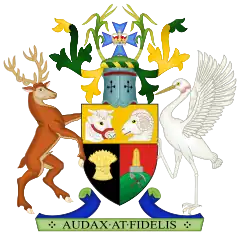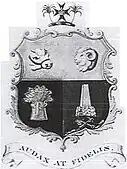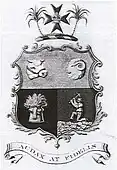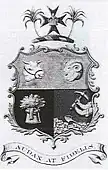| Coat of arms of Queensland | |
|---|---|
 | |
| Versions | |
 State Badge of Queensland | |
| Adopted | 1893 |
| Crest | Two stalks of sugarcane surround the State Badge, a Maltese Cross with a centred Crown of St. Edward |
| Torse | Green and gold |
| Blazon | Wheat sheaf, gold rising from a pile of quartz, the heads of a bull and a ram |
| Supporters | Red deer and brolga |
| Motto | Audax at Fidelis "Bold but Faithful" |
The coat of arms of Queensland is one of the formal symbols of the State of Queensland and represents the King's constitutional authority throughout the state.[1] It is the oldest of the state arms of Australia, having been granted in 1893 by Queen Victoria, through the simplest heraldic grants of only the shield of arms, motto, helmet, mantling and crest.[2] In 1977, the red deer and the brolga were assigned as supporters by Queen Elizabeth II during her Silver Jubilee.[1]
Suggestions and submissions
The original coat of arms were designed by Sir Albert Woods, Garter King of Arms (head) of the Heralds College. He created four different designs (produced below) which were sent to the Chief Secretary and Premier of Queensland, Sir Samuel Griffith who selected the design that Woods favoured.[2] In order to ensure secrecy, the choice of arms was communicated by telegraph to London using the respective code words, "Halfpay", "Halfprice", "Iceblink" and "Icebound".[2]
 Proposed design "A" (Halfpay)
Proposed design "A" (Halfpay) Proposed and ultimately selected design "B" (Halfprice)
Proposed and ultimately selected design "B" (Halfprice) Proposed design "C" (Iceblink)
Proposed design "C" (Iceblink) Proposed design "D" (Icebound)
Proposed design "D" (Icebound)
Heraldic description

The blazon of the coat of arms is:[3]
For arms, per fesse the Chief Or, the Base per pale Sable and Gules, in Chief a Bull’s head caboshed in profile muzzled a Merino Ram’s head respecting each other proper, the dexter Base harged with a Garb also Or and the sinister Base on a Mount a Pile of Quartz issuant therefrom a Gold Pyramid in front of the Mount a Spade surmounted by a Pick saltirewise all proper.
And for the crest, on a wreath of the Colours, a Mount thereon a Maltese Cross Azure surmounted with a Royal Crown between 2 sugar-canes all proper.
And for the Supporters, on the dexter side a Red Deer and on the sinister side a Brolga wings elevated and addorsed both proper, below on a scroll this motto, 'Audax at Fidelis'.
Modernised, this means:[4]
Across the top of the shield a gold panel on which there is a bull's head in profile muzzled, cut off at the neck and a merino ram's head, facing each other, both naturally coloured. In the lower portion of the shield on the left hand side on the black background a golden sheaf of wheat; on the right side on a red background and on a green mound, a golden obelisk standing on a pile of quartz with a crossed pick and shovel in the foreground.
Development and change
The development of the coat of arms continued during the year and by the end of 1893, the Maltese Cross impaled with a crown had been incorporated, above the shield in between the two stalks of sugar cane.
In 1902 the heraldic depiction of the British Imperial Crown was standardised to the (symbolic) Tudor Crown. Following 1963, this was switched to a depiction of St Edward's Crown.[5]
The final and current addition to the coat of arms was created in 1977, the Silver Jubilee of Queen Elizabeth II, with the granting of the red deer and brolga as supporting animals. The deer represents the old world and it is a classic animal of heraldry while the brolga represents the native population and is also the state's official bird.[2]
Industrial influence
The symbols on the shield are representations of Queensland's most abundant industries. The wheat industry's origins belong with the first settlers in 1788, as the farms were worked by the convicts brought over from England, an idea of Governor Phillip.[6] During the years till 1795, the wheat industry slowly gained popularity and by the late 19th century was a strong force in the agricultural industry of the state. The sugar industry became established by 1868 in Mackay which was a mere four years after the first commercial sugar mill was opened in Cleveland, south of Brisbane.[7] Sugar and Coffee regulations were brought in by Parliament later that year as the industry spread rapidly and with the creation of the Mackay Central Sugar Mill Manufacturing Company ten years later in 1878, the sugar industry had reached its colonial peak.[8]
The sheep industry had been in existence since the early 1820s within Australia and by the early 1880s the geographical expansion of this industry had hit Queensland in which major wool auctions were held throughout the state.[9] The mining industry began with the discovery of copper on 20 May 1867 by Ernest Henry in Cloncurry and the industry climbed with the Gold Rush which occurred on 3 September 1873 when gold was discovered in Georgetown.[10] The beef industry was quite prevalent by the late 1880s and by 1890, Queensland had exported Australia's first major export overseas which consisted of 1500 tons and by the 20th century that number had exploded to 43000 tons.[11]
Supporting animals
The brolga is one of Australia's two native crane species and the only one solely found in Australia.[12] They stand 1 m tall with a wing-span of up to 2.4 m. They are generally grey and are known for their distinctive energetic mating dance as well as their loud trumpeting "garooo" call.[13] They are mostly found along the coast from Rockhampton to the Gulf of Carpentaria and subsequently became the official bird emblem of Queensland in January 1986.[14]
The red deer is a traditional beast of heraldry and was introduced into Queensland from the royal herds near London.[15] Despite their position on the coat of arms, deer are a declared feral pest in Queensland with it being illegal to distribute, trade, release into the environment, move or feed any deer under the Biosecurity Act 2014.[16]
Maltese Cross
The Maltese cross has a stranger history than the rest of the elements upon the arms. Not even the Queensland government is aware of why the Maltese Cross was chosen for the coat of arms, as described in the letter below which resides in the Queensland State Archives.[17]
25th January 1966
Dear Mr Nicholson,
As promised in our telephonic conversation yesterday, I append such information as we have concerning the origin of the use of the Maltese Cross in the Queensland Badge and Coat of Arms. I might mention that the relevant facts involved were decided by officers of this Department from old records and from certain correspondence this Office had had the Agent General many years ago as a result of a similar enquiry.
Briefly, the story is that on 23rd August 1873, the Secretary of State for the Colonies circulated the various Colonies as to the adoption of distinctive badges.
When this request was received in Queensland, the then Acting Colonial Secretary, Mr W Hemmant, wrote to the then Governor, His Excellency Mr WW Cairns, in the following terms –
"Referring to the Circular Despatch of the Secretary of State for the Colonies, dated the 23rd August last, upon the subject of distinctive badges proposed for the Flags of several Colonies, I have the honour to advise Your Excellency that the difficulty of producing upon bunting a fair representation of the head or bust of Her Majesty has proved so great, and the effect, when produced, so unsatisfactory, as to render it necessary to abandon the idea of using that device for the Queensland Ensign, and I beg therefore to recommend that the accompanying design, within a wreath of laurel, be adopted for the Flags of the Colony in lieu of that formerly advised.
The Governor forwarded a copy of this letter to the Secretary of State for the Colonies with 'two copies of the device which Mr Hemmant and myself have approved in substitution for the present Badge of the Colony. If Your Lordship should be pleased to adopt the proposed device of the Maltese Cross with the Crown in the centre as the future Badge of the Colony for the Governor and Government vessels, an intimation to that affect would receive the immediate attention of the Executive Council."
On 16th July 1876, in a dispatch to the Governor of Queensland, the Lords Commissioners of the Admiralty approved at the device submitted and on 29th November 1876, the following appeared in Queensland Government Gazette, Vol XIX, No. 64.
The Treasury Queensland Brisbane, 15 November 1876
GOVERNMENT NOTIFICATION
His Excellency the Governor, with the advice of the Executive Council, has been pleased to direct that in the future the Badge of the Colony be emblazoned in the centre of the Union Flag for use by the Governor and to the employment at the Queensland Government shall be as herein after described:-
ARGENT ON A MALTESE CROSS AZURE A QUEEN'S CROWN PROPER
James R Dickson Colonial Treasurer
Subsequently, the design was incorporated as part of the Queensland coat of arms when the royal warrant authorising the present device for the Queensland coat of arms was issued to the state of Queensland on 29 April 1893.
It is not known for certain exactly why the Maltese Cross with a superimposed crown was chosen as suitable Badge. Over the years, various theories have been propounded and the one given best credence is that as the Victoria Cross was first bestowed in 1857 by Queen Victoria at the close of the Crimean War and as Queensland was established in 1859, it would be a natural association of ideas to ally Queensland with the Victoria Cross which is a form of the Maltese Cross with Royal Arms and lion superimposed.
This latter theory, and the fact that the actual proposal of the Maltese Cross was not put forward until 1876 – quite some years after Governor Bowen had left Queensland – are regarded as significant arguments against the theory that there was some association between the Maltese Cross and Lady Bowen.
I am enclosing a copy of the Government Gazette Notification of 26th November 1959, which gives heraldic description of the State Badge and Coat of Arms, and trust that this and the foregoing information will be of assistance to you.
Yours Sincerely,
RB McAllister Under Secretary
Gallery
Below is a visual evolution of Queensland's coat of arms.
.svg.png.webp) Queensland's official coat of arms at the beginning of 1893.
Queensland's official coat of arms at the beginning of 1893..svg.png.webp) Queensland's official coat of arms from the end of 1893 to 1902, and again from 1953 to 1977.
Queensland's official coat of arms from the end of 1893 to 1902, and again from 1953 to 1977..svg.png.webp) Queensland's official coat of arms from 1902 to 1963.
Queensland's official coat of arms from 1902 to 1963. Queensland's official coat of arms since 1977.
Queensland's official coat of arms since 1977.
References
- 1 2 "Coat of Arms". Queensland Government. 5 July 2017. Retrieved 3 December 2023.
- 1 2 3 4 Elvery, Niles (23 July 2013). "Queensland Coat of Arms". State Library Of Queensland. Retrieved 18 September 2023.
- ↑ Emblems of Queensland Act 2005 (Qld) s ch1 (schedule 1)
- ↑ The Heraldry and Genealogy Society of Canberra (2004) 'State and Territory Arms of Australia', "State and territory arms of Australia". Archived from the original on 22 February 2005. Retrieved 1 June 2008., [9 March 2004]
- ↑ "State badge". www.qld.gov.au. Retrieved 1 December 2023.
- ↑ Dunsdorfs, Edgars (1956) 'The Australian Wheat Growing Industry 1788–1948', University Press, Melbourne, Victoria, Australia, pp6
- ↑ Kerr, John (1988) 'A Century of Sugar', Watson Ferguson, Brisbane, Queensland, Australia, pp10
- ↑ Kerr, John (1988) 'A Century of Sugar', ibid., pp16
- ↑ Ville, Simon (2000) 'The Rural Entrepreneurs', Cambridge University Press, Victoria, Australia, pp42
- ↑ Carroll, Brian (1977) 'Australia's Mines and Miners', Macmillan Publishing, Melbourne, Victoria, Australia, pp30
- ↑ Kelly, JH (1971) 'Beef in Northern Australia', Australian National University Press, Canberra, Australia, pp11
- ↑ "Brolgas". Bush Heritage Australia. 3 December 2023. Retrieved 3 December 2023.
- ↑ "Brolga". BirdLife Australia. Retrieved 3 December 2023.
- ↑ "Bird emblem". Queensland Government. 5 July 2017. Retrieved 3 December 2023.
- ↑ Department of the Prime Minister and Cabinet (2022). Australian Symbols (PDF). Australian Government. p. 40. ISBN 0 642 47131 2.
- ↑ Brisbane City Council. "Feral deer". Brisbane City Council. Retrieved 15 June 2023.
- ↑ Queensland State Archives (1966) 'Flag, Badge, Arms and Seal of Queensland', SRS1043, 1, 267, 84